
May 8 2018
Contributors: EMMA JONES, MICHELLE SAMUELS-JONES & Matthew Trent Trainum, Ed.D.
We know that leaders in today’s higher education landscape must be comfortable with disruption, adaption, and “failing forward fast.” As you are growing in or into a leadership role in your department, campus, or community, how would you rate your readiness or abilities around these five actions?

1. Design around continuous learning and emerging trends. Leaders are effective change agents, and change agents are voracious trend watchers who ensure their teams have exposure to emerging practices in their fields. Change leaders support professional learning focused on new possibilities, and they stay connected to evolving technologies and pathways. Whether it’s learning a new social media platform to stay engaged with your student constituents or researching the latest ways to use data to link your university’s enrollment and marketing efforts, what are you learning?
Your opportunity: Stay alert to the wider higher education landscape and imagine what comes next. What is one tangible learning opportunity you can identify for yourself and for your team? For example, start a book club, attend a lunch-and-learn, sign up for a webinar series, or start an article sharing group to connect yourself and your team to trends and innovations.

2. Support risks. Redistribute power, resources, and decision-making away from a simple reliance on established, formal systems. A culture that embodies risk also has to embody forgiveness. What is your current tolerance for risk taking, both for yourself and your team? Rank yourself on a scale in which one represents a very low tolerance for risk taking and five represents a very high tolerance for risk taking. Consider how you can push yourself to be more comfortable with risk. The best way to challenge yourself is to start now with engaging in risk.
Your Opportunity: Support the habit of experimentation, prototyping, and piloting at all levels. What is one opportunity you can identify today to begin to get comfortable with risk taking? What decision do you have to make or delegate that falls outside of your comfort zone? What steps can you take to sit with the discomfort and “fail forward fast”? Beyond the risk lies the reward!

3. Take a systems approach. A systems approach means thinking holistically across all levels of your institution. On an organizational level, seek to understand the interconnected layers of your work—and the work of your team/s—and build strong connections in many different directions. On an individual level, allow yourself and your team to see the consequences of your/their actions and your/their impact on others and the organization.
Your Opportunity: Translate messages across boundaries and connect your team to broader organizational priorities. Do your teams know the priorities of the president, vice presidents, or directors across the organization? How many shared projects does your area contribute to?
.jpg?width=600&height=397&name=bruno-scramgnon-bulb-idea-315658%20(1).jpg)
4. Strategically challenge existing ways of thinking. We realize how challenging this one can be, especially in higher education where change seems to happen slowly, and the status quo is hard to disrupt. When you are attempting to incorporate fresh, innovative ideas, asking questions can often lead others to the conclusions that you’ve already come to. Asking, versus telling, can also pave the path for innovation beyond where your thought process landed, and take the team or campus to higher heights and deeper depths of knowledge and change.
Some good questions to ask are:
- What would it look like if…?
- Why are we (still) doing it this way?
- Why do we think about it this way?
- What are we not thinking about?
- Is there a deeper issue we’re not confronting?
- Why? Why? Why?
To challenge the status quo, encourage a sense of positive urgency across the organization. Know resistance is part of the process, and be flexible along the way. Reinforce a culture of valuing individuals, connecting the community, and conducting courageous conversations.
Your Opportunity: Ask tough questions of each other, challenge existing mental models, and shift to adaptive thinking and deeper questions.

5. Champion new ideas constantly. Anchor new efforts to lasting organizational and institutional values (i.e., “the noble cause”), to history and mission, to societal concerns, and to market demands. Define the organization as open to innovation by sharing a value of, openness to, and excitement for new ideas. Take a lesson from the improvisational (“improv”) community; instead of saying, “no, because,” respond more frequently with, “yes, and…”. Change cannot happen if new ideas are constantly batted down and “because-ed” away.
Your Opportunity: Advocate for new ideas persistently, positively, loudly, transparently, and collectively. Support internal and external ideas with resources and goodwill. Sometimes new ideas don’t fit into the existing schema or status quo. Ask yourself, is it the new idea that is faulty, or is it the framework through which we are viewing the idea that needs to be disrupted?
A change leader influences those around them through advocacy, vision, and drive, and provides access to resources as a way encourage and incorporate change (Higgs and Rowland, 2000). We know change has arrived to higher education. Are you on the forefront of change? What would you add to our list?
Save, print, and prominently post this chart to keep innovative change leadership at the forefront of your mind and decision making. Download here.
Related Blog Posts
Recent Posts
- Richard Dunsworth, J.D., To Receive 12th Annual Courageous Leadership Award December 16 2024
- Meet the 2024 Credo Values Award Recipients August 27 2024
- What is Executive Coaching, Really? June 25 2024
- Credo & The Constructive Dialogue Institute Announce A New Partnership For Higher Education Leadership Development March 7 2024
- Celebrating Women And Gender-Diverse Learners & Leaders February 28 2024
Categories
- Strategy
- Leadership
- Student Success
- Student Success & Retention
- Enrollment
- Pivot
- Strategic Planning
- Leadership Development
- News
- Strategic Enrollment
- Campus Planning and Architecture
- Moving the Needle
- Data
- Research
- Retention
- Campus Master Planning
- Enrollment & Financial Aid
- Academic Programming
- Campus Planning
- Thriving
- Admitted Student Research
- Architecture
- Finance
- Advising
- Admissions




